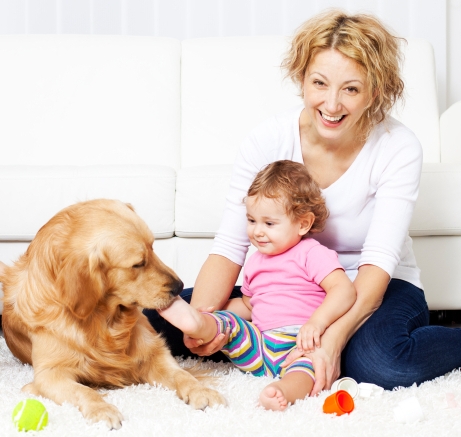Your baby is at a playful age: clapping hands, playing peek-a-boo and becoming more mobile. And now that the warmer weather is here and families are spending more time outdoors, it seems like the perfect time to present her with her first friend: one of the furry persuasion.
But before you head out to the animal shelter or pet store, it’s important to consider which pets are ideal companions for young children and what precautions to take when adding an animal to your growing family.
Factoring in Fido
Even before picking a pet, experts recommend first determining whether owning a pet now is the right time in your household. “A pet is a long commitment in terms of resources, both financial and emotional,” says Elise Gouge of PetBehaviorConsulting.com. “Consider how much time and energy you will have to train and care for a pet.”
Lifestyle is another important consideration, especially if you’re thinking about a puppy. “If you are a family on the go, how will you be sure your dog’s needs are being met,” asks Jennifer Shryock, a certified dog behavior consultant and director of FamilyPaws.com, a national parent education program. “Dogs are very social and want to be with their families.”
If your child is relatively young, a puppy may not be the best choice. “Puppies take time, patience and a great deal of work to be well-mannered,” she adds. “Parents often get frustrated with this combination [of baby and pet].”
Best for Baby
Once you feel your family is ready for a new pet, think about what type of animal would work best with young children. “Cats may be easier to deal with if there are time constraints,” suggests Dr. Keith Niesenbaum, a veterinarian with Crawford Cat and
Sometimes, older is better, concurs Gourge. “Many times, choosing an adult pet is more advantageous since you can already see what the pet’s temperament is,” she says. “Especially with pets like cats, what you see in a kitten is not predictive of who the cat will be as an adult. Choosing an older pet who’s personality is already defined—and indicates they really love babies and young children—can be the way to go.”
And of course, taking into account your own disposition doesn’t hurt either. “Ultimately, it all comes down to the parents being committed and dedicated as much as they can about each type of pet, so that they can make the best choice for their family.”
Playing it Safe
Now that you’re ready to adopt a new member of the family, be sure you have the proper set-up in place. Experts strongly recommend outfitting your home with the proper safety equipment and taking the necessary steps to ensure a smooth transition for everyone.
“Preparing for a new pet is much like preparing for a baby,” notes Gouge. “That means making sure the house is proofed against chewing dangerous things like wires or wood, and restricting access to certain areas such as the baby’s room.” Safety gates are also advisable.
And when coming home with your new pet, try to minimize the initial excitement for the animal. “Keep everyone calm and let the new pet adjust over a couple of days to their new surroundings,” offers Dr. Niesenbaum. That means giving your pet plenty of space, including designating a secure feeding location where no prying faces or fingers will disturb food and water bowls.
“A new pet is exciting, but new is the key here,” says Shryock. “All living creatures need time to adapt to a new home environment and become familiar with the people around them.” Animals that are overwhelmed will lead to eventually become stressed and difficult to engage. “Relationships with animals take time, and bonds do not happen overnight,” she adds. “Short, successful encounters is the way to achieve a balanced relationship.”




